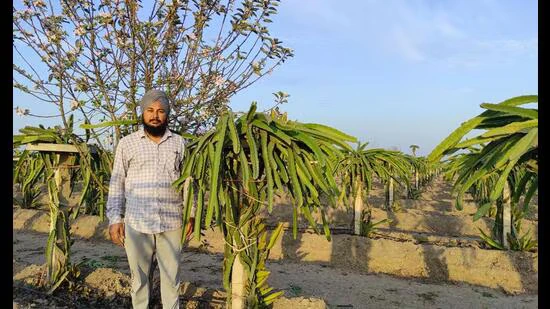Sangrur/Barnala – Amid growing concerns over depleting groundwater and declining profits from the traditional wheat-paddy rotation, farmers in Punjab are increasingly embracing a new, sustainable option: dragon fruit cultivation.
What started as a cautious experiment is now showing strong economic potential. Farmers across Sangrur and Barnala districts are reporting substantial profits from the seasonal crop, which requires far less water than paddy and fruits from June through October.
“Dragon fruit is proving to be a sustainable alternative. Once planted, the crop lasts for years and needs minimal watering,” said Sukhpal Singh, 45, from Kakarwal village in Sangrur. He began cultivating half an acre using only organic inputs—vermicompost, dung cakes, and bio-fertilizers. “I expect 4 to 5 quintals this season, and I’m selling directly to consumers in Dhuri at ₹300 per kg,” he said, estimating earnings of ₹2.5 lakh. “This is a chemical-free crop, low-maintenance, and water-saving. One watering can sustain the plant for 10 days.”
Balwinder Singh, a 67-year-old farmer from Rogla village in Sangrur, switched to dragon fruit cultivation in 2021. “We yield around 25 to 30 quintals per acre during the season and sell at ₹200 per kg,” he said. With just one acre under the ‘C’ variety, he now earns ₹4–5 lakh per season by marketing across districts.
In Thulewal village, Barnala, Satnam Singh has gone bigger. Dedicating four acres to the ‘American Beauty’ variety, the 38-year-old supplies fruit to Bathinda, Ludhiana, Jalandhar, and Barnala. “We’re getting 35 to 40 quintals per acre and earning ₹4 to ₹5 lakh per acre,” he said. “It needs much less water than paddy, and there are virtually no disease issues.”
Experts agree that dragon fruit offers a viable model for crop diversification in Punjab, where climate change and resource depletion are pressing concerns.
“Horticulture can help increase farmer income while conserving the environment,” said Dr Mandeep, associate director at Krishi Vigyan Kendra. “Drip irrigation users are eligible for a ₹10,000-per-acre government subsidy. But lengthy paperwork and coordination with the soil conservation department often deter farmers from applying.”
He urged farmers to use certified planting material from government nurseries and attend training sessions offered through the centre.
Chief agriculture officer Dr Jagsir Singh called diversification a “model for the future” and encouraged cultivators to seek help whenever needed. “Our department is open to supporting any farmer facing hurdles with new crops like dragon fruit,” he said.
As the state searches for sustainable farming models, the shift toward horticulture is not just about profits—it’s about survival.

